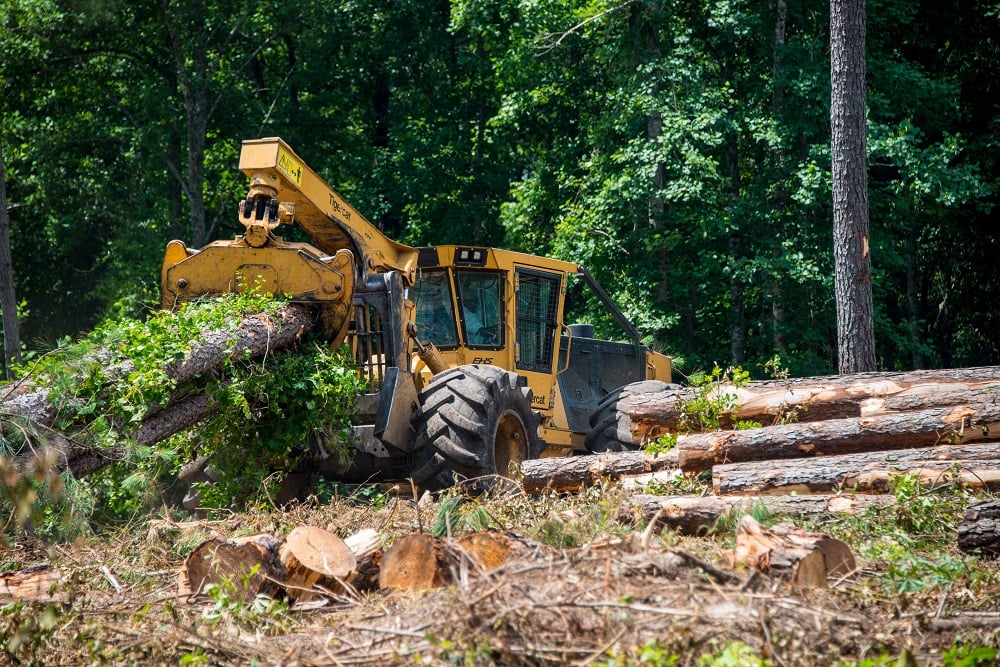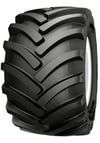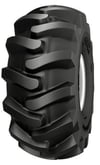Primex Flotation Forestry Tires
Logging equipment operates in some of the most demanding conditions for tires—steep slopes and muddy ground make traction a challenge while sharp stumps, branches, and rocks threaten puncture at all times. Forestry tires must also contend with the heavy weight and huge horsepower of modern logging equipment, along with the task of hauling hefty loads out of the forest. For such an imposing environment, the forest floor is surprisingly sensitive and the damage done during timber harvest can last for decades.
To deal with this conundrum, many logging operations are turning to flotation tires featuring rugged construction to stand up to extreme environments and the tough tasks required of them, while also reducing the impact logging equipment has on the forest and improving sustainability.

Flotation Tires on the Farm
The use of flotation tires is relatively new in forestry, but they’ve been popular on the farm for decades thanks to their ability to support larger and more powerful ag equipment and minimize yield-inhibiting soil compaction. The Alliance brand was at the forefront of flotation tires, developing one of the first diagonal flotation tires in the early 1990s and the industry’s first radial flotation tires in the late 1990s.
Flotation Tires in the Forest
Flotation tires are becoming popular on logging equipment for many of the same reasons farmers first adopted them 30 years ago—namely, loggers are using heavier and higher-powered equipment. Today’s logging equipment weighs 25% to 30% more than that of a decade ago with many machines weighing upward of 55,000 pounds.
Also, similar to farmers, the growing understanding loggers have of the long-term impact machines have on the forest as well as their bottom lines. Minimizing damage to the forest floor speeds up forest regeneration, improves the rate of biomass production, and in many cases helps build stronger relationships with sellers or fulfill lease requirements—all of which add up to more income.
What is a Flotation Forestry Tire?
Flotation tires are designed with a wide profile that increases the size of a tire’s footprint. The advantages of a flotation tire include:
- Better traction
- Greater range
- Less impact on the soil
Better Traction
Because a flotation tire has a larger footprint, it puts more tread on the ground and provides superior traction. This is particularly noticeable when operating in wet, muddy conditions and slick, swampy terrain. Working in the mud is an increasingly common occurrence for today’s loggers—according to a University of Wisconsin study, the time in which the ground in northern temperate forests is frozen has declined by two to three weeks since 1948. Another benefit of the better grip—and reduced slipping and sliding—provided by flotation tires is improved fuel economy.
Greater Range
The improved traction provided by flotation tires also allows loggers to enter otherwise inaccessible terrain (such as steep hillsides and boggy low-lying areas), expanding the terrain where they can harvest. Just as important as getting into tough terrain is getting out and flotation tires give operators the confidence that they won’t get stuck, need to be hauled out, or wait for the ground to firm up. This is especially important since keeping expensive equipment productive is vital to profitability.
Less Impact
The large footprint of a flotation tire distributes the weight of massive modern logging machinery over a larger surface area and minimizes the impact equipment has on the ground, such as soil compaction, which can inhibit seed germination, growth, and increase mortality.
Flotation tires can also help prevent forestry equipment from tearing up the forest’s root mat and disturbing the availability of vital nutrients. They also help stave off deep ruts that can channel erosion and increase erosion—both of which can slow regeneration and lead to angry landowners.
Flotation vs. Dual-Tire Setups
Different operations have different needs; consequently, there is no one-size-fits-all tire solution. In general, flotation tires are ideal for logging operations that are consistently working in wet and swampy forests, thanks to their superb performance in wet conditions and the ease of managing their inflation pressure.
Conversely, dual-tire setups are a good choice for loggers who commonly work on dry or frozen ground and only need additional flotation some of the time. Dual-tire setups offer excellent flexibility as operators can add or remove the outer tire when needed which limits wear and tear on the outer tires. The downside of these setups is that they are tricky to maintain—checking and adding air pressure to the inner tire is time-consuming on a dual-tire setup.
Primex Power
 No matter the needs of your logging operation, Primex has a tire for you. Our Primex Log Stomper Super High Flotation has the massive footprint and delicate touch that sensitive soils need to remain sustainable while featuring the robust construction—steel under-tread plies, reinforced sidewalls, and special cut- and chip-resistant compound—required for working in the most taxing terrain.
No matter the needs of your logging operation, Primex has a tire for you. Our Primex Log Stomper Super High Flotation has the massive footprint and delicate touch that sensitive soils need to remain sustainable while featuring the robust construction—steel under-tread plies, reinforced sidewalls, and special cut- and chip-resistant compound—required for working in the most taxing terrain.
 Tires like the Primex Log Monster and Log Stomper Xtreme are favorites of loggers using dual- and single-tire setups alike. Both tires feature aggressive 23-degree angle lugs, deliver excellent self-cleaning, and possess a variety of features to increase durability such as dual beads, steel belts, and special compounds.
Tires like the Primex Log Monster and Log Stomper Xtreme are favorites of loggers using dual- and single-tire setups alike. Both tires feature aggressive 23-degree angle lugs, deliver excellent self-cleaning, and possess a variety of features to increase durability such as dual beads, steel belts, and special compounds.
Contact your local Primex dealer or representative to learn more about how Primex tires can benefit your operation.

